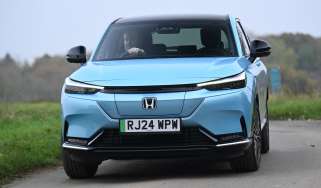Volkswagen ID.7 - Boot space, comfort & practicality
Those after comfort and practicality won’t be disappointed by the highly practical Volkswagen ID.7

The Volkswagen ID.7’s large hatchback body gives it a practical advantage over rivals in this large EV class that stick with the traditional saloon format. All ID.7 models come with front and rear parking sensors, plus a 360-degree camera system to improve visibility when parking – although the latter has a lower-resolution feed than we’d expect of a car costing over £50,000. Standard LED-matrix headlights provide very good visibility at night while also adjusting the beam pattern to avoid dazzling oncoming traffic.
|
Dimensions | |
|
Length |
4,961mm |
|
Width |
1,862mm (2,141mm including the mirrors) |
|
Height |
1,536mm |
|
Number of seats |
5 |
|
Boot space |
532-1,586 litres |
Dimensions and size
The car’s length alone means the Volkswagen is a much more spacious car than a BYD Seal or Tesla Model 3. The ID.7 is 241mm longer than the Model 3, and 161mm longer than a Seal, so factor that into your calculations about where you’ll park it. The ID.7 isn’t as wide as the Seal, but it is taller than both of its rivals.
Go for the ID.7 Tourer, and both the length and width remain the same as the hatch, but the height goes up by 15mm to 1,551mm.
How practical is the Volkswagen ID.7?
Seats & space in the front
Adults who are six feet tall will have no trouble getting comfortable in the front of the ID.7. All versions come with electrically adjustable front seats with memory settings on the driver’s seat, and there’s electric lumbar support for additional comfort. There’s also plenty of head, leg, and shoulder room to stretch out in.
The centre console is tall and there’s plenty of storage space under the centre armrest, plus a pair of cup-holders ahead of it under a roller cover. The front door bins are generously sized and are flocked to prevent items from rattling in them as you drive along.
Seats & space in the back]
The vast length and wheelbase of the ID.7 are really felt in the back, where kneeroom is limo-like, and (according to our tape measure) headroom is far more generous than in the likes of the BMW i4 or Tesla Model 3. The well equipped Match trim comes with electric adjustment on the front seats, including electric lumbar adjustment, memory settings, and seat-depth adjustment, so there’s plenty of scope to find a comfortable driving position.
Families with young children who need child seats will be pleased to find Isofix child seat mounting points conveniently hidden behind some removable plastic covers on the outer positions of the rear seats. There are also Isofix mounts on the front passenger seat to provide some flexibility in where you can put child seats.
Boot space
Put simply, the Volkswagen ID.7 has a huge 532-litre boot that dwarfs the Model 3’s 425-litre luggage area. Folding the rear seats down in the ID.7 increases capacity up to 1,586 litres, with the 60:40-split bench lying almost flat, making an IKEA run that little bit easier. All models get a variable-height boot floor to remove the annoying load lip and provide a space beneath the floor where you can store the charging cables or even the parcel shelf if you need to remove it.
There is the Volkswagen ID.7 Tourer estate if you need even more boot space, with 605 litres available with the seats up, and 1,948 litres with the seats down – the latter figure is even greater than a similarly configured Skoda Superb Estate or Mercedes E-Class Estate.
Despite the saloon shape being less practical than a traditional estate, the ID.7 still has a roof-hinged hatch, which works wonders for accessibility when loading bigger items. The boot opening in the ID.7 is much bigger than the narrow, letterbox-like opening you’ll find in both the BYD Seal and Tesla Model 3.
Towing
With the introduction of the Pro S version, the Volkswagen ID.7 can be ordered with a tow bar (for just over £1,000) to complement this version's 1,000kg braked towing capacity. Opting for the four-wheel-drive GTX model not only helps with traction on wet grass, but increases the towing capability to 1,200kg.
Neither figure is a huge amount for car of this size and weight. If you want more capacity and still need some electrified driving, the plug-in eHybrid versions of Volkswagen Tiguan and Volkswagen Passat can both handle a 1,800 kg caravan or trailer.










